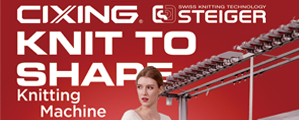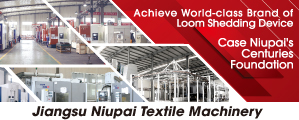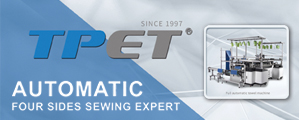Industrial textiles:The market demand still remains vigorous
Feb 14, 2019 | by
Favorable industrial operation
In 2018, China’s industry of textile products for industrial use waded through a complex development environment, but the demand on major markets was relatively stable. Policies subsequently promulgated by the Chinese government to support development of the real economy played an increasingly important role. On the whole, the industry was enjoying a favorable development. That the production and sales steadily grew but the profit growth rate dropped would be initially curbed.
According to the data of National Bureau of Statistics, the industrial added-value increase rate was 8.4% from January to November, higher than the average of the manufacturing industry and which was even at a leading level within the textile industry.
From January to November, the non-woven fabric output of enterprises beyond the designated scale will reach 3.518 million tons, which was 9.67% higher than the year before, and the grow rate was faster than that of the same period last year by 9%. Both the domestic market and the overseas market of non-woven fabric products demonstrated a strong demand throughout the year. The output of tire cloth was 589,000 tons, increasing by 2.08% compared with the year before, and the growth rate of the period in 2017 and 2018 was almost the same. The decreasing output of automobiles influenced the downstream tire cloth market to some extent. From January to November, the operating income and profit margin of textile products for industrial use in China reached 231.6 billion yuan and 12.04 billion yuan, respectively, increasing by 8.45% and 3.76%, respectively. The growth rate increased by 2% and 4% compared with the same period last year. The total profits, after experiencing slight reduction, gradually resumed to the current medium-and low-speed growth.
From January to November, the average profit rate of enterprises above the designated scale reached 5.20%, which was on an upward trend but was still lower than that of the same period last year by 0.24 percent points. A major reason for the declining profit rate of the industry was the rising cost resulted from fluctuations of the raw material price. In some fields, intensification of competition resulted in the failure of the product selling price to be synchronously increasing with the cost. Segmentation of operation among enterprises led to a slide in the industry’s overall profitability. From January to November, the losses scale of enterprises above the industrial scale reached 12.51%, increasing by 3.4% compared with that in the same period last year. The losses of enterprises increased by 43.6%. Small enterprises and enterprises with a singular product structure, at the end of the product life cycle and slow in innovation were confronted with more difficulties. The profits kept on dropping even to a losing state. Large-scale enterprises performed well in technological innovation. The product differentiation degree was high, and the fine management was effective. The bargaining power with the downstream and upstream enterprises was strong. All these contributed to a strong development momentum. In the first three quarters, the operating income and total profits of 15 listed companies in the industry increased by 12.26% and 35.69%, respectively, and the average profit rate reached 16.27%。
Seen from subsidiary industries, one could find a significant improvement in the performance of the non-woven fabric performance. The operating income and total profits of non-woven fabric enterprises increased by 8.86% and 1.49%, respectively. The export data showed that the average price of non-woven fabric increased by a small margin. The operating income and total profits of other textile products for industrial use (including filtering, civil engineering, protection, traffic, and composite material) increased by 10.84% and 17.81%, respectively. The average profit rate was 5.96%, increasing by 0.35% compared with the same period last year, and was at a leading level in the whole textile industry. The operating income of ropes and cables, though increasing by 4.94%, experienced an overall drop of 6.69% in their total profit margin.
From January to November, the export shipment value of enterprises above the industrial scale increased by 5.34%. According to data issued by China Customs, China exported 832,000 tons of non-woven fabric cloth to foreign countries from January to November 2018, and the export amount reached 2.58 billion USD, which increased by 2.5% and 8.7%, respectively, compared with the same period last year. The export price of non-woven fabric cloth increased by 6%. In the first three quarters, the non-woven fabric imported by the United States from China reached 255 million USD, and the market share of China’s non-woven fabric cloth on the American market increased slightly.
According to the Japanese customs data, around 229,000 tons of non-woven fabric were imported from Japan to China, which was worth around 86.59 billion Japanese yen, and declined by 4.64% and 5.07%, respectively, compared with the year before. On the contrary, the non-woven fabric exported from China to Japan reached 37.88 billion Japanese yens, registering a year-on-year decrease of 12.5%.
In-depth product development
The industry of fiber products for industrial use has a close bearing on the chemical fiber new material innovation. With the growing maturity of new material technology, textile products for the industrial use also entered an in-depth development period.
Innovation of chemical fiber new materials was mainly reflected in three aspects: Functional fiber material development and quality development, high-performance fiber industrialization and product serialization, biological base chemical-fiber industrialization.
Functional fibers which are inflaming-retarding, bacterial-resistant, and anti-static found wide applications in the field of special textile products, traffic tool inner decoration materials, high-end textile products, and hygienic materials for the medical use. Production and process technologies, including carbon fibers, polyimide fibers, high-performance polyethylene fiber, high-modulus aramid fibers, and polytetrafluorethylene fibers experienced a significant improvement and realized industrialization. The high-level R&D system initially took shape for carbon fibers, aramid fibers, and basalt fibers.
The biological base chemical fibers and the raw material core technology achieved new progress to initially form an industrial scale. The new solvent method cellulosic fibers, biology base nylon fiber, chitosan fiber, alginate fiber spinning, and key and original technologies for finishing industrialization achieved remarkable breakthroughs.
The multifunctional non-woven technology improved the comprehensive performance of textile products for medical and hygiene use. The high-barrier protection suite for the medical use, hernia repair network, soft tissue patching materials, and blood vessel prosthesis already entered the application or clinical experimentation stage. The new-type war training suits, fire-fighting suits, emergency rescue suits and suits for occupational protection improved the protection and rescue efficiency and effectively safeguarded life security. The new-type anti-flaming high-strength warp-knitting polyester grating upgraded the security and economy of the coal mine supporting system. The intelligent civil engineering materials ensured the quality of infrastructure and provided an integrated solution plan for soil consolidating, structural safety monitoring and pre-warning.








